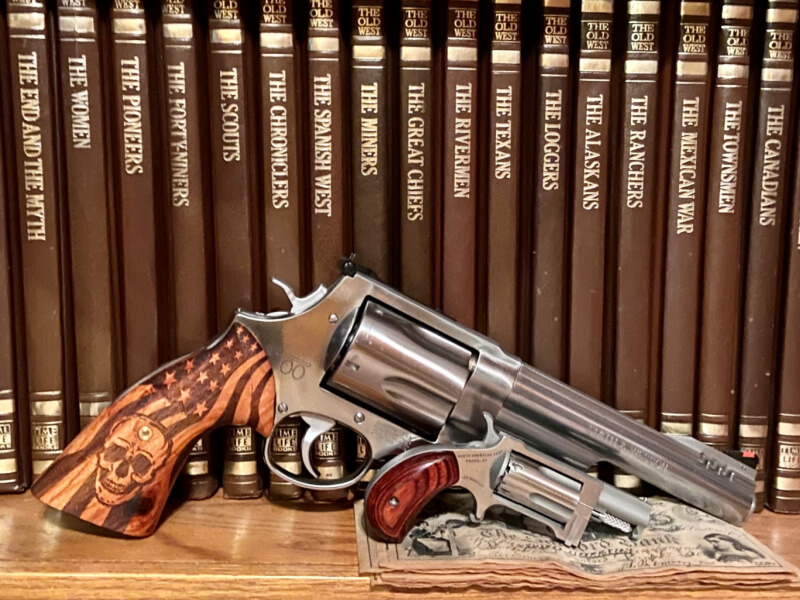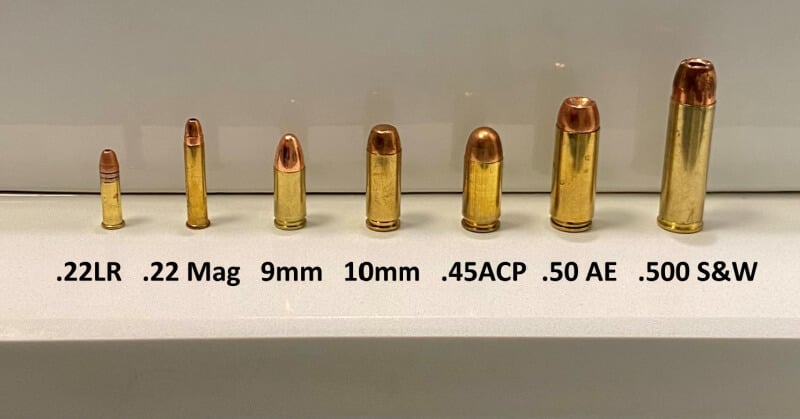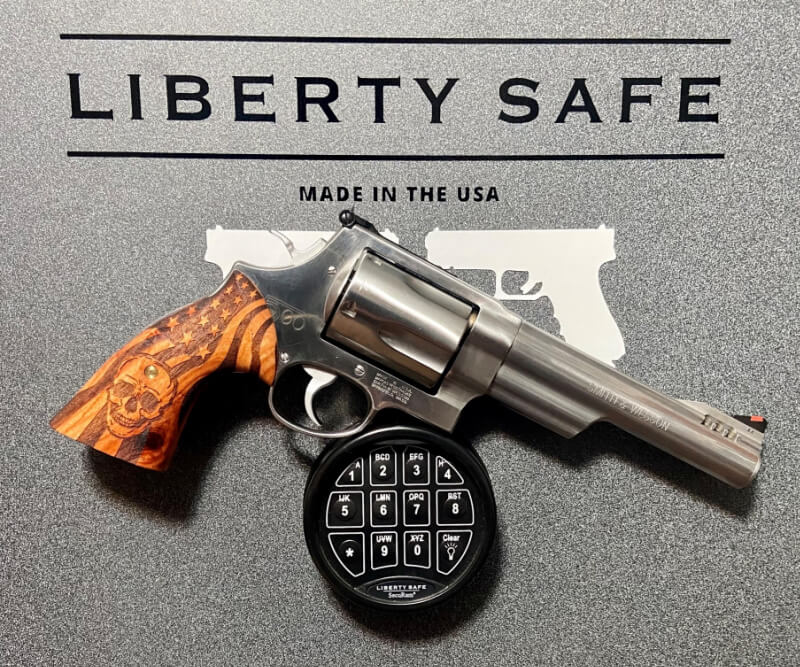Across my handgun collection, the majority of my guns are semi-automatics. However, the largest and smallest handguns are both revolvers. Though about as different in purpose as two handguns can be, they share several key features as revolvers. Both have five-round cylinders, are traditional side swing-out loading revolvers, and are manufactured for a very specific purpose. These two guns are my Smith & Wesson X-Frame 500 Magnum and my North American Arms (NAA) Sidewinder.

In both cases, my current models are not my first. In the case of the S&W 500, my first one was a shorter ported barrel that came with a holster. For the NAA .22 Magnums, I first had one that required removal of the cylinder to reload compared to my newer one with a traditional swing-out cylinder.

The Large: S&W 500 Magnum
The S&W X-Frame 500 Magnum may not be the most powerful handgun ever, but it can claim the title for being the most powerful production handgun not chambered in a round intended for rifles. The .500 Magnum was co-developed by Cor-Bon and S&W as a handgun hunting round powerful enough to be used on any big game found in North America. S&W released the 500 Magnum at the 2003 SHOT Show and though some specialty handguns have been released with greater power since, it has retained its title as the most powerful production handgun. Beyond hunting, it was also purposed as an outdoor defensive handgun for large North American bears. The S&W 500 has been successfully used at moderate and closer ranges to hunt even the largest animals across the globe.

My purchase of the S&W 500 was driven by my love of larger-bore guns. It is a favorite among people shooting on my home range. For them, it offers a rare shooting experience and is unlike larger-bore semi-automatics that are often hard to operate and control. For some shooters, the S&W 500 is actually quite manageable. Everyone lets out a gasp when I bring the rounds out (I will admit to theatrics here as I always make sure we just shot 9mm for a quick size comparison). However, due to the weight and single-action option, the recoil is generally manageable, though still impressive.
There is a clear subjective joy to shooting the S&W Magnum. Everyone who has shot mine sheepishly asked if they could shoot another five rounds. The overall fit, look, and function is excellent. It easily loads and ejects spent casings. The double-action trigger is consistent, and the single-action press is clean and crisp. It is also remarkably accurate and many a hole has been driven deep into the targets on my range.
The downside of this revolver is the cost of ammunition. If your plans are big game handgun hunting or if you are planning outdoor adventures where the predators tend to be larger, this is a high-quality gun manufactured exactly for that purpose. If you don’t hunt, it makes a great addition to any collection. And, it will become one of your most requested range guns if you enjoy letting others shoot your firearms.

The Small: North American Arms Sidewinder
My love of big-bore firearms (or secret worry that T-Rex’s may make a return) drove my decision to add the S&W 500 to my collection. My decision to purchase the NAA Sidewinder was driven by practicality. At the time, I was regularly attending a 24-hour gym. Though the gym was supposedly secure, there had been some late-night / early-morning incidents. I had therefore decided that I wanted something that could be easily and safely concealed in my gym clothes (not just nearby in a gym bag).
I purchased my first NAA .22 Magnum with a leather pocket holster soon after and have since added one with a folding grip that serves as a trigger guard / holster, and finally the Sidewinder. These .22 Magnum 5-shot single-action-only revolvers from NAA provided a very concealable option that was easy to slip into a pair of gym shorts. The Sidewinder added the ability to (in theory) reload more quickly compared to previous NAA offerings and I added five extra rounds of .22 Magnum to the pocket holster.
With our last move, we decided to add a home gym to the new house and the original purpose of the NAA was no longer valid. I still have my Sidewinder in my carry rotation, but it now almost exclusively gets used when I am teaching a Methods of Concealed Carry class or as a backup to my backup gun.

The advantages of the NAA Sidewinder for deep concealment are many, including its size and weight. The firearm is also well suited to a smaller lighter holster as the hammer rests between rounds in a notch when carried and must be brought back to allow firing through the single-action trigger.
Having 5 rounds of .22 magnum in a very small and light package allows for some level of preparation in situations that would make a larger firearm sub-optimal. That said, there are potential downsides.
First, one of the advantages of a traditional firearm is the very real possibility of a psychological stop. Psychological stops occur when a gun is recognized and becomes a deterrent to further aggression. I have often wondered if the very small Sidewinder would have this same effect. Would it even be recognized as a firearm?
Once loaded the Sidewinder works very reliably. I have shot hundreds of rounds through it with no firearm-related issues. Reloading even with the Sidewinder can be difficult and is unlikely to be done quickly.
Finally, the gun’s accuracy is what I would define as very close range. I am reasonably accurate (defensive hits) out to about 15 feet but at any greater distance, I am no longer confident in my ability to hit only what I have aimed at with this firearm. This level of accuracy also was not ‘out-of-the-box’ and is the reason I can attest to the reliability (hundreds of rounds fired).
Finally, though shooting a relatively small round, the small and light nature of the gun and limited grip area results in a fair amount of felt recoil. Compared to the S&W 500 there is little joy to shooting this gun for fun, but it can be an option between being unarmed and having a firearm in certain difficult to conceal situations.
Both guns have their role and are natural bookends to my collection.



